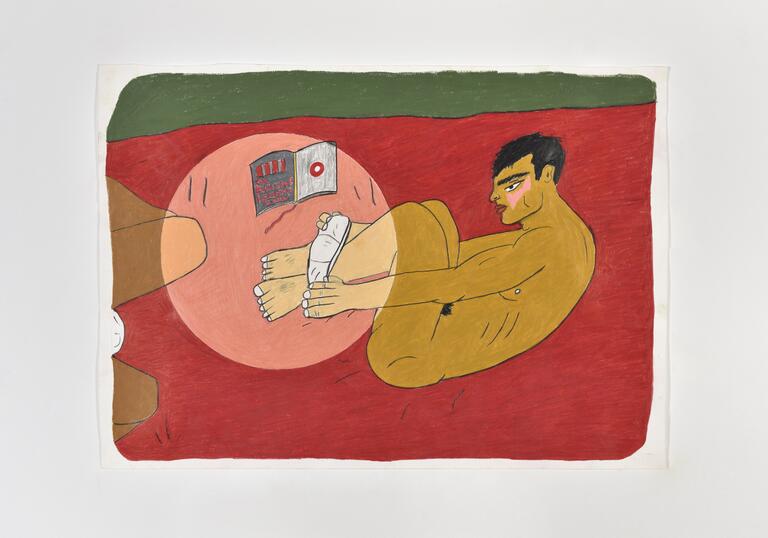Press room
Soufiane Ababri: Their mouths were full of bumblebees but it was me who was pollinated

Soufiane Ababri, Bedwork, 2023, Between two paragraphs of Oscar Wilde’s reading © Soufiane Ababri, photo Rebecca Fanuele
From March 2024, the poignant and exuberant works of Moroccan-born artist Soufiane Ababri transform the Barbican’s Curve gallery for his first solo exhibition at a major UK institution. Living and working between Paris, France, and Tangier, Morocco, Ababri’s interdisciplinary practice encompasses drawing, sculpture, installation, and performance. His work cites sources from sociology, philosophy, and the canon of western gay subculture, and is often inspired by real and fictitious encounters with other men.
Ababri's commission connects the crescent shape of The Curve gallery to the curling form of the Arabic letter Zayin (ز). This is the first letter of the word ‘Zamel’, a derogatory term for gay men deriving from ‘Zamil’, meaning close or intimate friend. In the Maghreb, the buzzing of this consonant is used insidiously, insinuating the slur without explicitly voicing it. Ababri takes the transformation of Zamil into Zamel as his starting point to investigate the ways in which language has been coded and weaponised. In doing so, he reveals how homophobia continues to threaten not only same-sex sexuality but undermines the possibility of intimate, non-heteronormative relationships based on radical forms of friendship.
Inspired by a thirteenth-century illustration by Yahya ibn Mahmud al-Wasiti that depicts a tender moment between two men holding hands and looking into each other’s eyes, through this commission Ababri is engaging in art historical activism. Drawing from western and non-western queer experience, his work challenges traditional representations of intimacy and sexuality. In their place, he forges an alternative canon, reversing the historic marginality of non-heterosexual relations.
A site-specific performance responding to the shape of The Curve will address the power architecture can hold over our bodies and its ability to influence our behaviour. Ababri references the history of clubs as sites of resistance for the queer community and explores the role of dance and music as tools for personal and collective emancipation.
Soufiane Ababri said: When I saw the architectural plans for The Curve, its emblematic crescent reminded me of the curling shape of the letter ‘zayin’. An artist is always in tension with the space offered to them, and I hope to use the structure of The Curve to reflect on social determinism – how my own experiences of harassment and the insult ‘zamel’ have shaped my response to this space. I asked myself: is suspicion a necessary element in a critical discourse? How could I use this commission to question relationships of power and domination, whilst making space for joy and a celebration of intimacy?
Shanay Jhaveri, Head of Visual Arts at the Barbican, said: “We are delighted to present the first exhibition of Soufiane Ababri’s work in a UK institution. His show provocatively responds to the distinctive architecture of The Curve, reminding visitors of the continued vulnerability of queer communities, but also of their resilience, strength and the joy found on the dance floor.”
Ababri’s previous works have demonstrated a shared fascination with probing gender roles, social dynamics, and eroticism through his characteristically kaleidoscopic lens. He considers the lingering legacy of colonial structures in homophobia, racism, and what might pass as socially acceptable expressions of intimacy. Humour and irreverence are ever-present, subverting the notes of violence which darken the horizons of the work and resisting the strained reality of living and working in Morocco, a place where homosexuality remains illegal.
Soufiane Ababri (b. 1985 Rabat, Morocco) holds a Post-Diploma from the École Supérieure des Beaux Arts, Lyon, France, as well as an MA from the École Nationale Supérieure des Arts Décoratifs, Paris, and a BA from the École Supérieure des Beaux Arts de Montpellier, France. He has exhibited in various institutions in Europe and worldwide with solo and group shows across Paris, Berlin, London, and Los Angeles. His work is included in the collections of the MAC/VAL and the FRAC Poitou-Charentes in France as well as the Museum of African Contemporary Art Al Maaden (MACAAL) in Marrakesh, Morocco, and X Museum in Beijing, China.
This exhibition is supported by Fluxus Art Projects
Soufiane Ababri:
Their mouths were full of bumblebees but it was me who was pollinated
The Curve
13 March – 30 June 2024
Media View: Tuesday 12 March, 10am – 1pm
#SoufianeAbabri @barbicancentre
Hannah Carr - Communications Manager, Visual Arts : [email protected] / 020 3834 1191
Lily Booth - Communications Officer, Visual Arts : [email protected]
Georgia Holmes - Communications Assistant, Visual Arts : [email protected]
